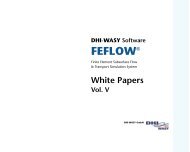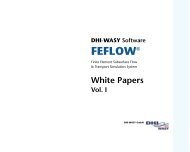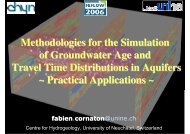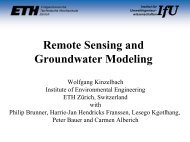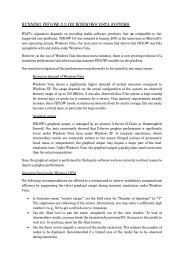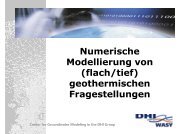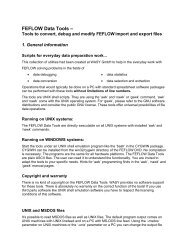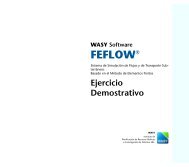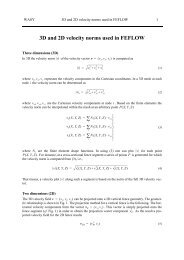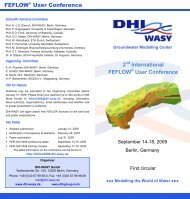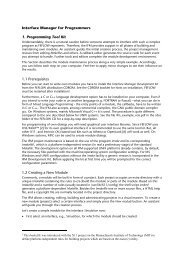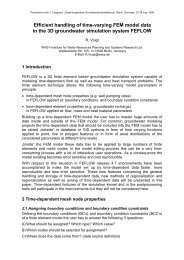Challenges of Fluid Flow in Absorbing Porous Media ... - FEFlow
Challenges of Fluid Flow in Absorbing Porous Media ... - FEFlow
Challenges of Fluid Flow in Absorbing Porous Media ... - FEFlow
You also want an ePaper? Increase the reach of your titles
YUMPU automatically turns print PDFs into web optimized ePapers that Google loves.
<strong>Challenges</strong> <strong>of</strong> <strong>Fluid</strong> <strong>Flow</strong> <strong>in</strong><br />
Absorb<strong>in</strong>g <strong>Porous</strong> <strong>Media</strong> & Th<strong>in</strong> Layers<br />
Rodrigo Rosati*<br />
Pr<strong>in</strong>ciple Eng<strong>in</strong>eer,<br />
Procter & Gamble - Baby Care R&D<br />
FEFLOW 2009 Conference<br />
Berl<strong>in</strong>/Potsdam, Germany<br />
September 15, 2009<br />
Procter & Gamble © 2009<br />
Dr. Mattias Schmidt<br />
Research Fellow – Victor Mills Society,<br />
Procter & Gamble - Baby Care R&D
ABOUT THE PRESENTER<br />
Rodrigo Rosati is a Pr<strong>in</strong>cipal Eng<strong>in</strong>eer at P&G,<br />
work<strong>in</strong>g <strong>in</strong> the Baby Care R&D at Schwalbach<br />
Technical Center, Germany.<br />
He jo<strong>in</strong>ed P&G <strong>in</strong> 1999, after graduat<strong>in</strong>g <strong>in</strong> Chemical<br />
Eng<strong>in</strong>eer<strong>in</strong>g at the University <strong>of</strong> Salerno, Italy. He<br />
has worked <strong>in</strong> the area <strong>of</strong> fluid flow model<strong>in</strong>g and<br />
absorbent core design s<strong>in</strong>ce 2003.<br />
Procter & Gamble © 2009
• P&G at a glance<br />
Outl<strong>in</strong>e<br />
• Importance <strong>of</strong> Model<strong>in</strong>g & Simulation for R&D<br />
• <strong>Fluid</strong> <strong>Flow</strong> <strong>in</strong> Hygiene Products<br />
– Introduction<br />
– Introduction to Diaper Cores and AGM<br />
– Impact <strong>of</strong> AGM swell<strong>in</strong>g on fluid flow<br />
• Typical challenges and opportunities for<br />
collaboration<br />
Procter & Gamble © 2009
It began with Soap & Candles…<br />
Founded <strong>in</strong><br />
1837<br />
Procter & Gamble © 2009<br />
•Fifth Oldest<br />
Company on the<br />
Fortune 50…<br />
Procter & Gamble © 2009<br />
William<br />
Procter<br />
Candle Maker<br />
James<br />
Gamble<br />
Soap Maker
P&G at a Glance<br />
First Consumer goods company <strong>in</strong> the world<br />
More than 300 brands<br />
More than 5 Billion consumers <strong>in</strong> more than 160<br />
countries<br />
Operations <strong>in</strong> more than 80 countries<br />
140 plants and 25 R&D centers worldwide<br />
ca. 138.000 employees<br />
Net sales: $83 Billion<br />
Net earn<strong>in</strong>gs: $12 Billion<br />
R&D Investment: >$2 Billion<br />
Procter & Gamble © 2009
Billion-Dollar<br />
Brands<br />
Procter & Gamble © 2009
Importance <strong>of</strong><br />
Model<strong>in</strong>g & Simulation for R&D<br />
Procter & Gamble © 2009
"<br />
!<br />
"<br />
#<br />
#<br />
Procter & Gamble © 2009<br />
!
Typical <strong>Challenges</strong><br />
Products must perform when used<br />
… But face Fundamental<br />
Eng<strong>in</strong>eer<strong>in</strong>g Contradictions.<br />
•Materials … strong but s<strong>of</strong>t—even wet, stretch not<br />
break, breath but conta<strong>in</strong>, break…not tear/selectively<br />
tear.<br />
•Liquids … mixtures can’t separate, must stay where<br />
applied…but dispense easily.<br />
•Packages … design is key, be strong but light, never<br />
leak but open easily.<br />
Procter & Gamble © 2009
Time<br />
days<br />
hrs<br />
sec<br />
ms<br />
ns<br />
fs<br />
Computational<br />
Chemistry<br />
Quantum<br />
Chemistry<br />
- subatomic<br />
Scales <strong>of</strong> Model<strong>in</strong>g<br />
Molecular<br />
Mechanics<br />
-atoms,<br />
molecules<br />
Coarse Gra<strong>in</strong><br />
or Mesoscale<br />
Model<strong>in</strong>g –<br />
Polymers<br />
angstroms nm microns mm m<br />
Distance<br />
Procter & Gamble © 2009<br />
Cont<strong>in</strong>uum or<br />
F<strong>in</strong>ite Difference<br />
F<strong>in</strong>ite Element<br />
MechEng/ChE<br />
(Closed Form<br />
Equations)<br />
Industrial Eng/<br />
Operations Resrch<br />
(Statistical, Discrete<br />
Event, Agent Based)<br />
Computer Aided<br />
Eng<strong>in</strong>eer<strong>in</strong>g (CAE)<br />
km
<strong>Fluid</strong> <strong>Flow</strong> <strong>in</strong><br />
Absorbent Hygiene Products<br />
Procter & Gamble © 2009
Typical Liquid Handl<strong>in</strong>g Tasks <strong>in</strong> BabyCare<br />
DIAPERS WIPES<br />
Ur<strong>in</strong>e absorb & reta<strong>in</strong> remove (from sk<strong>in</strong>)<br />
BM conta<strong>in</strong> & absorb remove (from sk<strong>in</strong>)<br />
Lotion melt, release & deposit release & deposit (spread)<br />
(spread)(onto sk<strong>in</strong>) (onto sk<strong>in</strong>)<br />
Procter & Gamble © 2009
Typical BabyCare Liquids<br />
Viscosity Surf. Tension Key <strong>in</strong>gredients<br />
Ur<strong>in</strong>e ~1 cP ~50 ... 65 mN/m water, salts, urea,<br />
surfactants<br />
BM ~10 6 ... 10 15 cP ~30 ... 60 mN/m water, bacteria, fibers,<br />
muc<strong>in</strong>s, surfactants, salts<br />
Lotion solid at RT low (temp dep.) petrolatum, stearyl alcohol,<br />
(Diaper) aloe<br />
Lotion ~1 ... 500 cP ~30 ... 65 mN/m Water, silicone (2-3%),<br />
(Wipes Wipes) polymer (stabylen),<br />
preservatives, surfactant<br />
Procter & Gamble © 2009
<strong>Porous</strong> <strong>Media</strong> <strong>Flow</strong><br />
• Simulation <strong>of</strong> fluid flow <strong>in</strong> porous structures<br />
applied to product design <strong>of</strong> „paper products“<br />
e.g. Diapers, Fem<strong>in</strong><strong>in</strong>e Pads, Towels, Swiffer, Wipes,<br />
Make-up-Applications, Olay Facial Wipes ...<br />
• Be<strong>in</strong>g used to develop new designs and new<br />
materials<br />
• Richards equation is a typical formulation<br />
Procter & Gamble © 2009
Absorbent Core Model<strong>in</strong>g<br />
(<br />
" + + % ,<br />
)<br />
Procter & Gamble © 2009<br />
! "<br />
# ! "<br />
*<br />
$ % & '
Diaper Core Technology<br />
Diaper (from Side )<br />
Front <strong>of</strong><br />
Diaper<br />
Waist feature<br />
Acquisition Patch<br />
Backsheet Dust<strong>in</strong>g Layer<br />
Storage Core (blend<br />
<strong>of</strong> AGM and cellulose)<br />
Procter & Gamble © 2009<br />
Lotion Stripes Topsheet<br />
Inside Surface<br />
Back <strong>of</strong><br />
Diaper<br />
Outside Surface
Acquisition &<br />
Distribution<br />
•Nonwoven Layer<br />
•Modified Cellulose<br />
Fibers<br />
How does a diaper work?<br />
Liquid Handl<strong>in</strong>g Tasks <strong>of</strong> diaper Cores<br />
<br />
Procter & Gamble © 2009<br />
Storage Core:<br />
AGM + Cellulose
F<strong>in</strong>al<br />
Absorption<br />
How does a diaper work?<br />
Liquid Handl<strong>in</strong>g Tasks <strong>of</strong> diaper Cores<br />
• AGM can absorb about 30 times <strong>of</strong> its own weight, whereas cellulose can<br />
absorb only around 4 times <strong>of</strong> its own weight.<br />
AGM<br />
70%<br />
Pampers Core<br />
Procter & Gamble © 2009<br />
Airfelt 30%
- .<br />
What is AGM?<br />
+ / + 0 0<br />
+ +<br />
0 + + / + 1 2<br />
CO2H<br />
Na +<br />
3 // 4 / + + 0<br />
Procter & Gamble © 2009<br />
O<br />
O<br />
R - C - Et<br />
C = O<br />
COO<br />
Na +<br />
CO2H<br />
CO2H<br />
Na +<br />
COO<br />
Na +<br />
CO2H<br />
Na +
• Take up ur<strong>in</strong>e and lock it away – as much as possible!<br />
Procter & Gamble © 2009<br />
(Storage Capacity)<br />
• Transport ur<strong>in</strong>e with<strong>in</strong> itself, e.g. with<strong>in</strong> a swollen gel bed.<br />
• Work reasonably fast.<br />
Function <strong>of</strong> AGM<br />
(Permeability)<br />
(Speed)
5 (<br />
!<br />
6 ) -<br />
What is „Gel Block<strong>in</strong>g“?<br />
5<br />
5<br />
Procter & Gamble © 2009<br />
(
∂S<br />
∇ • J + φ<br />
∂t<br />
Model<strong>in</strong>g <strong>Fluid</strong> <strong>Flow</strong> <strong>in</strong> Diaper Cores:<br />
Non swell<strong>in</strong>g <strong>Porous</strong> <strong>Media</strong><br />
=<br />
0<br />
kkr<br />
ρ<br />
µ<br />
J = −<br />
cap<br />
p( S) = p<br />
saturation<br />
1<br />
0.9<br />
0.8<br />
0.7<br />
0.6<br />
0.5<br />
0.4<br />
0.3<br />
0.2<br />
0.1<br />
0<br />
des<br />
( ∇P<br />
− g)<br />
p p 0 − abs ( Smax<br />
) S −<br />
p ( )<br />
0 S max<br />
0 2 4 6 8 10<br />
pressure (kPa)<br />
absorption measurement<br />
desorption measurement<br />
absorption fit<br />
desorption fit<br />
<strong>in</strong>complete cycle<br />
<strong>in</strong>complete fit<br />
Cont<strong>in</strong>uity Equation<br />
Darcy‘s Law<br />
1<br />
1<br />
n<br />
(<br />
m<br />
)<br />
des<br />
−1<br />
des<br />
+ p ( S )<br />
abs<br />
Procter & Gamble © 2009<br />
max<br />
Implementation <strong>of</strong><br />
capillary pressure<br />
hysteresis
Model<strong>in</strong>g <strong>Fluid</strong> <strong>Flow</strong> <strong>in</strong> Diaper Cores:<br />
AGM-conta<strong>in</strong><strong>in</strong>g cores<br />
• AGM absorbs liquid „away from the pores between AGM<br />
particles and fibers“<br />
– Acts like a „s<strong>in</strong>k term“ <strong>in</strong> the fluid flow equation <strong>of</strong> the pore structure<br />
– Liquid absorbed <strong>in</strong>to each AGM particle by diffusion / osmotic process<br />
– Swell<strong>in</strong>g <strong>of</strong> AGM changes the pore structure<br />
• Described as „two types <strong>of</strong> liquid“<br />
– m 1 : „mobile fluid“ <strong>in</strong> the pore structure<br />
– m 2 : „immobile“ fluid <strong>in</strong> the gel<br />
• Requires modified equation system<br />
– Richards equation extended by „s<strong>in</strong>k term“<br />
– Key properties <strong>of</strong> pore structure now depend on m 2<br />
– Additional equation for absorption <strong>of</strong> liquid <strong>in</strong>to the gel phase<br />
Procter & Gamble © 2009
Swell<strong>in</strong>g Model Equations<br />
Procter & Gamble © 2009
Example: Multilayer Core Structure <strong>in</strong>cl. AGM<br />
• Pictures show snapshots <strong>of</strong> fluid <strong>in</strong> pores (~saturation) and fluid <strong>in</strong> AGM at two different<br />
times after a gush onto a pre-loaded core<br />
• Illustrates how upper acquistition layers and <strong>in</strong>terstitials are be<strong>in</strong>g dewatered and fluid is<br />
absorbed <strong>in</strong>to the AGM<br />
Short time after gush „In equilibrium“ after gush<br />
Procter & Gamble © 2009
<strong>Challenges</strong> & Opportunities for<br />
Collaboration<br />
Procter & Gamble © 2009
Typical <strong>Challenges</strong><br />
• Designs are long / large area but very th<strong>in</strong><br />
– Difficult to mesh properly (balance <strong>of</strong> speed / accuracy)<br />
• Product developers want the answers fast<br />
– Computation time, stability <strong>of</strong> simulations new algorithms<br />
– Need to be able to run lots <strong>of</strong> simulations<br />
• Extreme material properties<br />
– Typical porosities ~90% or higher<br />
– Large parameter contrast <strong>in</strong> K(S) and Pc(S) and hysteresis<br />
– Properties change dur<strong>in</strong>g use (swell<strong>in</strong>g, external pressure changes)<br />
– Th<strong>in</strong> materials (see below)<br />
• Multiple physical effects<br />
– <strong>Porous</strong> <strong>Media</strong> <strong>Flow</strong><br />
– Free Surface <strong>Flow</strong><br />
– Mechanical Deformation<br />
• Liquids can be difficult<br />
– Surfactants – Surface tension as function <strong>of</strong> time, Surfactant Transport<br />
– Non-newtonian effects – most equations do not apply to high porosities<br />
Procter & Gamble © 2009
Opportunities for Collaboration<br />
• <strong>Fluid</strong> flow models <strong>in</strong> presence <strong>of</strong><br />
– Th<strong>in</strong> layers<br />
– Hydrophobic layers / bridg<strong>in</strong>g<br />
• Micromodels to predict K(S, p ext ), Pc(S, p ext ), n(p ext )<br />
– Design materials with target K(S), ...<br />
• (More direct) Measurement <strong>of</strong> K(S)<br />
• Initial wett<strong>in</strong>g behavior <strong>of</strong> very dry materials (analogy to<br />
soil)<br />
• Experimental characterization <strong>of</strong> surfactant release and<br />
transport <strong>in</strong> porous media<br />
Procter & Gamble © 2009
Th<strong>in</strong> Layers – Key Def<strong>in</strong>itions & Relevance<br />
• A „th<strong>in</strong> layer“ is characterized by typical pore dimensions that are<br />
similar (order-<strong>of</strong>-magnitude) to the thickness (or: the smallest<br />
dimension) <strong>of</strong> the layer.<br />
Only few number <strong>of</strong> pore layers through the caliper<br />
Caliper (thickness) <strong>of</strong>ten non-uniform<br />
3D pore structure is <strong>in</strong>fluenced by <strong>in</strong>terface / adjacent layers<br />
• Why are th<strong>in</strong> layers so important <strong>in</strong> absorbent products?<br />
TS, AQL and NWCC have a big impact on speed <strong>of</strong> acquisition and dryness<br />
performance<br />
Acquisition System<br />
Top-sheet (TS): hydrophilic (spunbond) or hydrophobic (apertured TS)<br />
Storage Core<br />
Note: we are us<strong>in</strong>g 2 different systems<br />
1. NW AQL (Acquisition Layer) / curly fibers comb<strong>in</strong>ation (<strong>in</strong> most designs)<br />
2. NW AQL only (<strong>in</strong> low-tier designs)<br />
Procter & Gamble © 2009<br />
NWCC (non-woven core cover)<br />
NWDL (not fluid flow relevant)<br />
Backsheet (not fluid flow relevant)
Th<strong>in</strong> Layers – <strong>Challenges</strong>:<br />
Is Darcy Model still valid?<br />
Only few number <strong>of</strong> pore layers through the caliper<br />
For short pores, e.g. through the thickness <strong>of</strong> such porous materials, can<br />
we still assume that the permeability tensor is <strong>in</strong>dependent from the<br />
pressure gradient, given the <strong>in</strong>ertial effects at the <strong>in</strong>let/exit <strong>of</strong> the pores?<br />
How to def<strong>in</strong>e a consistent REV for these layers?<br />
Example <strong>of</strong> th<strong>in</strong> SMS (spunbond-meltblownspunbond)<br />
nonwoven: side view<br />
Procter & Gamble © 2009
Th<strong>in</strong> Layers – <strong>Challenges</strong>:<br />
Is Darcy Model still valid?<br />
Mesh<strong>in</strong>g<br />
Even regardless from the REV limitations, the th<strong>in</strong>ness <strong>of</strong> these materials<br />
results <strong>in</strong> significantly higher number <strong>of</strong> mesh elements, with <strong>in</strong>creased<br />
computational time and tough numerical challenges. Do we need a novel<br />
theory/approach address<strong>in</strong>g mesh<strong>in</strong>g/numerical challenges?<br />
Disconnected liquid / Instability effects may be present<br />
How can we describe these effects, particularly at the<br />
<strong>in</strong>terfaces?<br />
Procter & Gamble © 2009
Th<strong>in</strong> Layers – <strong>Challenges</strong>:<br />
Is Darcy Model still valid?<br />
„Bridg<strong>in</strong>g“ across the th<strong>in</strong> hydrophobic layer may be a<br />
dom<strong>in</strong>at<strong>in</strong>g effect*<br />
How to <strong>in</strong>corporate this effect <strong>in</strong>to Darcy Model?<br />
r<br />
R r<br />
r r<br />
R r<br />
r<br />
θ<br />
∆<br />
P B<br />
=<br />
R<br />
Procter & Gamble © 2009<br />
4γh<br />
2<br />
+ h<br />
2<br />
2γ<br />
cosϑ<br />
=<br />
R<br />
if<br />
else<br />
h ≤ R ⋅<br />
1−<br />
s<strong>in</strong>ϑ<br />
cosϑ<br />
∆P B : bridg<strong>in</strong>g pressure<br />
γ: surface tension <strong>of</strong> the liquid<br />
h: caliper <strong>of</strong> the sample<br />
R: radius <strong>of</strong> the largest pore<br />
ϑ.: liquid solid contact angle (> 90°)<br />
and ϑ > 90°<br />
* This means that the flow may not be just driven by<br />
capillary pressure differential but also by absolute<br />
pressures / curvature <strong>of</strong> meniscus.
Th<strong>in</strong> Layers – <strong>Challenges</strong>:<br />
Is Darcy Model still valid?<br />
Apertured Topsheet: example <strong>of</strong> hydrophobic<br />
porous material<br />
Procter & Gamble © 2009<br />
Apertured Topsheet Nonwoven before<br />
activation
Th<strong>in</strong> Layers – <strong>Challenges</strong>:<br />
Geometry & Surface Heterogeneity<br />
Inhomogeneous pore structure (patterned emboss<strong>in</strong>g, laydown, different fiber<br />
density, <strong>in</strong>terpenetration between layers at <strong>in</strong>terface)<br />
Inhomogeneous hydrophilicity (surface properties, surfactant coat<strong>in</strong>g &<br />
distribution, <strong>in</strong>terpenetration between layers at <strong>in</strong>terface)<br />
Additional challenge is the change <strong>of</strong> the fluid <strong>in</strong> contact upon surfactant wash-<strong>of</strong>f:<br />
liquid surface tension can be reduced from 72 mN/m to 30-40mN/m<br />
Example <strong>of</strong> bond<strong>in</strong>g pattern on a nonwoven<br />
material<br />
Procter & Gamble © 2009<br />
Curly fibers penetrat<strong>in</strong>g <strong>in</strong>to AQL
Th<strong>in</strong> Layers – <strong>Challenges</strong>:<br />
Lab Characterization<br />
• Difficult to characterize <strong>in</strong> the lab for their fluid flow model <strong>in</strong>put data<br />
Example: Capsorption<br />
Measure saturation dependent on hydraulic head<br />
<strong>Challenges</strong> :<br />
Th<strong>in</strong> layer uptake is only 200-300mg<br />
-> measure 10 layers<br />
-> use smaller frit<br />
Evaporation: 100mg/h<br />
-> tighter equipment (28mg/h)<br />
Procter & Gamble © 2009
• Th<strong>in</strong> NW layer<br />
Pc(S): Comparison 1 layer and 10 layers<br />
• 1 layer has more g/g<br />
uptake than 10 layers<br />
• Interfaces between<br />
sample and weight / frit<br />
form new pores<br />
• Difference <strong>in</strong> uptake<br />
especially at low<br />
pressures,<br />
i.e. large pore size<br />
(>0.3mm)<br />
Procter & Gamble © 2009
sample uptake per layer <strong>in</strong> g<br />
0.300<br />
0.250<br />
0.200<br />
0.150<br />
0.100<br />
0.050<br />
0.000<br />
1 vs. 10 layers – additional examples<br />
Scimat 1st cycle<br />
Topsheet 1st cycle<br />
Material A Material B<br />
0 20 40 60 80 100<br />
pressure <strong>in</strong> cm<br />
uptake per layer <strong>in</strong> g<br />
0.500<br />
0.400<br />
0.300<br />
0.200<br />
0.100<br />
0.000<br />
10 layers<br />
1 layer<br />
uptake per layer <strong>in</strong> g<br />
Neptune6 1st cycle Material C<br />
0 20 40 60 80 100<br />
pressure <strong>in</strong> cm<br />
Procter & Gamble © 2009<br />
0.450<br />
0.400<br />
0.350<br />
0.300<br />
0.250<br />
0.200<br />
0.150<br />
0.100<br />
0.050<br />
0.000<br />
0 20 40 60 80 100<br />
pressure <strong>in</strong> cm<br />
10 layers<br />
1 layer<br />
10 layers<br />
1 layer
Th<strong>in</strong> Layers – Opportunities<br />
• Implementation <strong>in</strong>to macroscopic fluid flow models<br />
– Partially saturated flow (2-phase)<br />
– Preference is to „<strong>in</strong>clude effectively“ <strong>in</strong>to Darcy / Richards<br />
Approach (e.g. Interfacial condition?)<br />
– Include mixed wettability<br />
– Surfactant release<br />
• Reliable lab characterization (model <strong>in</strong>put)<br />
– Th<strong>in</strong> layer characterization<br />
– Interface characterization<br />
• Model validation<br />
Procter & Gamble © 2009
Thank you!<br />
Questions?<br />
Procter & Gamble © 2009



